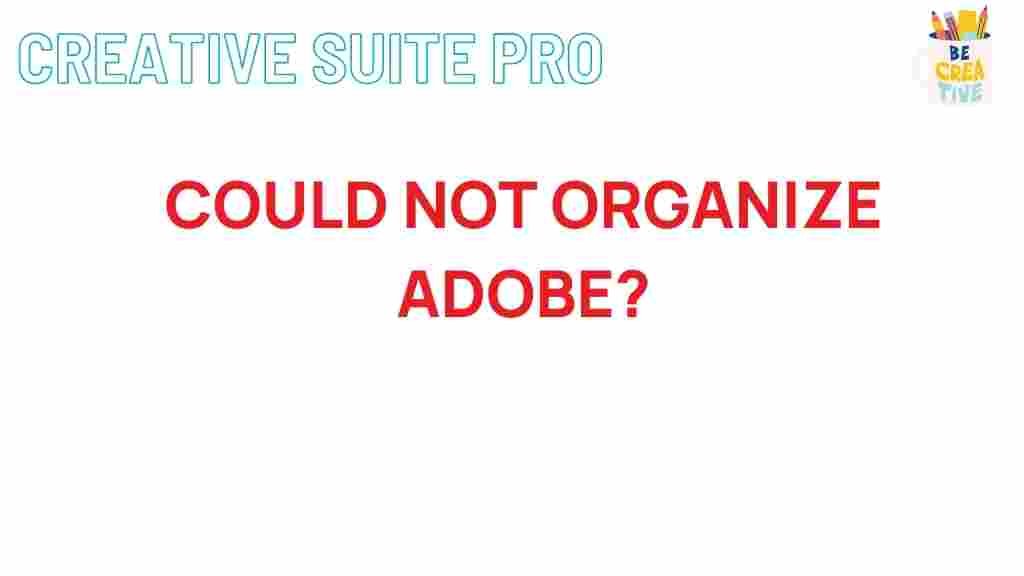Unleashing the Power of Adobe: Tips for Organizing Your Workspace
In the digital age, software tools like Adobe have become indispensable for creatives, marketers, and professionals across various fields. Adobe offers a suite of applications tailored for design, photography, video editing, and more. However, to fully harness the power of Adobe, it’s essential to organize your workspace effectively. In this article, we’ll explore tips for optimizing your Adobe workspace, helping you work more efficiently and creatively.
Understanding the Importance of Workspace Organization
Organizing your Adobe workspace is crucial for several reasons:
- Increased Productivity: A clutter-free workspace allows you to find tools and assets quickly, reducing time spent searching.
- Improved Focus: An organized environment minimizes distractions, allowing you to concentrate on your tasks.
- Streamlined Workflow: Customizing your workspace to fit your specific needs enhances your workflow, making tasks easier to manage.
Let’s dive into some actionable tips for organizing your Adobe workspace effectively.
1. Customize Your Workspace Layout
Adobe applications like Photoshop, Illustrator, and Premiere Pro allow you to customize the layout of your workspace. Follow these steps to create a personalized workspace:
- Access the Workspace Menu: Go to Window > Workspace in the top menu.
- Select a Workspace: Choose from default options like Essentials, Typography, or Painting as a starting point.
- Adjust Panels: Drag and drop panels to your preferred locations. You can group related panels together for easier access.
- Save Your Custom Workspace: After customizing, save your layout by selecting Window > Workspace > New Workspace.
By customizing your workspace layout, you can focus on the tools you use most often, enhancing your efficiency.
2. Organize Your Assets and Libraries
Adobe Creative Cloud includes Libraries, a powerful feature for managing your assets, such as colors, styles, and graphics. Here’s how to organize them:
- Create Libraries: Go to Window > Libraries to access your libraries. You can create multiple libraries for different projects.
- Tag and Name Assets: Use descriptive names and tags for easy identification. For example, use names like “ProjectA_Logo” or “Summer_ColorPalette.”
- Use Folders: Organize assets within libraries using folders to categorize them by project or type.
Organizing your assets ensures you can access the right elements without wasting time searching.
3. Utilize Keyboard Shortcuts
One of the most effective ways to streamline your workflow in Adobe is by using keyboard shortcuts. Familiarizing yourself with shortcuts can significantly reduce the time spent navigating menus. Here are some essential shortcuts:
- Photoshop:
- Ctrl + N: New Document
- Ctrl + S: Save Document
- Ctrl + Z: Undo
- Illustrator:
- Ctrl + C: Copy
- Ctrl + V: Paste
- Ctrl + D: Duplicate
Consider creating a cheat sheet of the shortcuts relevant to your most-used Adobe applications for quick reference.
4. Set Up a Color Palette
A well-organized color palette can make your designs more cohesive. Here’s how to create and organize your color palette in Adobe:
- Open the Color Panel: Go to Window > Color to access the color picker.
- Select Your Colors: Use the color picker or input specific color values (e.g., HEX, RGB) to choose your colors.
- Add to Swatches: Click the New Swatch button to save your selected colors for future use.
Having a consistent color palette will not only save time but also ensure brand consistency across your projects.
5. Regularly Clean Up Your Workspace
Just as physical spaces require decluttering, your Adobe workspace needs regular maintenance:
- Remove Unused Assets: Periodically review and delete assets in your libraries that are no longer needed.
- Archive Old Projects: Move completed projects to an archive folder to keep your active workspace uncluttered.
- Update Shortcuts: As you evolve in your projects, update your keyboard shortcuts to reflect your changing workflow.
Cleaning up regularly prevents unnecessary clutter and keeps your workspace efficient.
Troubleshooting Common Workspace Issues
Even with a well-organized workspace, you might encounter issues. Here are some troubleshooting tips:
- Panels Not Visible: If panels are missing, go to Window and ensure the desired panels are checked.
- Workspace Reset: If your workspace becomes cluttered or chaotic, you can reset it by going to Window > Workspace > Reset [Your Workspace Name].
- Application Lag: If Adobe is running slowly, consider clearing cache files or optimizing your computer’s performance.
Addressing these common issues will help maintain a smooth workflow in your Adobe applications.
Conclusion
Organizing your Adobe workspace is a critical step toward maximizing your productivity and creativity. By customizing your layout, organizing assets, utilizing keyboard shortcuts, setting up a color palette, and performing regular cleanups, you can create a workspace that enhances your efficiency. Remember, a well-organized workspace is not just about aesthetics; it directly impacts your work quality and speed.
For further reading on enhancing your creative processes with Adobe tools, check out Adobe’s official website. If you want to explore more tips and tricks, visit our blog section for additional resources.
This article is in the category Productivity and created by CreativeSuitePro Team
